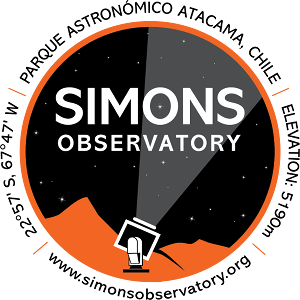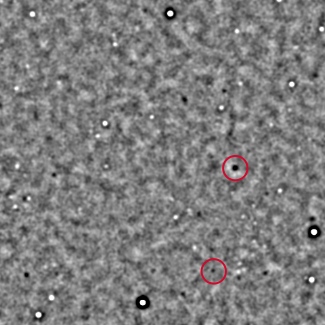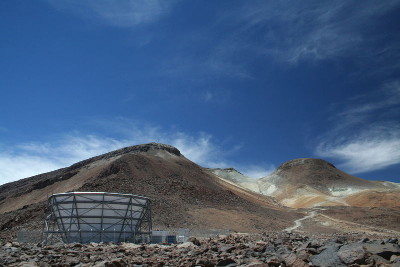Research: CMB
Measuring and understanding the cosmic microwave background (CMB) is a cornerstone of my research. Much of this is on the experimental side of things—meaning that I work on the telescopes that make these tricky observations—but I also analyse the data that we produce. Read more about these activities below.
On This Page: What is the Cosmic Microwave Background? • Experiments I Work On (The Simons Observatory, The Atacama Cosmology Telescope) • The Sunyaev-Zeldovich Effect
What is the Cosmic Microwave Background? [⯅ Top]

Image taken from Fig. 20 of Næss et al., 2020.
Long before stars or galaxies had formed, the Universe was a hot, dense gas that glowed at a few thousand degrees. Today, we can observe the light from this primordial glow, called the cosmic microwave background (CMB). Since it has come to us through a Universe that has expanded in size by a factor of over a thousand, the wavelength of the light has been stretched from the visible part of the spectrum to the microwave—on the order of millimetres. Observations of the CMB over the past two decades have provided solid support for the Big Bang theory while also yielding a surprising amount of information about the early Universe and about the make-up of the Universe on its largest scales. On small scales, the CMB not only bears a record of the early Universe, but also of the more recent Universe, since its light has passed through clusters of galaxies and other large structures which leave their own distinctive imprints on the primordial signal.
See also:
Experiments I Work On [⯅ Top]
The Simons Observatory [⯅ Top]

The Simons Observatory (SO) is an upcoming, multi-telescope observatory in the Atacama desert of northern Chile that will significantly improve the quality of CMB measurements. Construction is underway and we expect that the SO will make important scientific contributions, especially when its data are combined with observations made at other wavelengths of light. Some of the key science we will do includes:
- Probing the physics of the early Universe to test theories about the Big Bang.
- Better constraining how the Universe is expanding.
- Contributing to our knowledge of how galaxies form.
- Measuring the total mass of neutrinos, a fundamental but elusive particle in the make-up of the Universe.
Currently I am most involved in developing the software that will allow us to record, view and process the large volumes of data that the telescopes will record.
External Links of Interest
- Official Simons Website
- The Eternal Sky: A short documentary about the Simons Observatory.
The Atacama Cosmology Telescope [⯅ Top]
The Atacama Cosmology Telescope (ACT) is a six-metre telescope on Cerro Toco, in the mountainous desert of northern Chile, dedicated to making high-resolution measurements of the CMB.
Observations with ACT began in 2007, with major instrument upgrades taking place in 2013 and 2016. With our observations, we have made precise and detailed maps of the CMB that have contributed to confirming and tightening the precision of many of the fundamental parameters that characterise the Universe. We were the first group to detect gravitational lensing of the CMB by intervening cosmic structure, to provide evidence for dark energy using only the CMB, and are continuing to provide important lensing results. We were also the first statistically to measure the motion of galaxy clusters relative to the expansion of the Universe via the kinematic Sunyaev-Zeldovich effect. We have detected many clusters of galaxies (including a remarkably huge one) and done numerous follow-up studies of their properties. We have measured the microwave brightnesses of distant point sources and determined some of their important statistical properties.
In the past I've worked extensively on the nuts and bolts of ACT—or more precisely, on the software that allows us to use the software and understand the data we record. Currently most of my work consists of analysing aspects of our data.
External Links of Interest
- Official ACT Website and Wikipedia article
- Our 2020 data release in the popular press: BBC, CBC, Popular Mechanics
- ACT in Physics World's ‘Top-Ten Breakthroughs’ of 2012
- Articles about El Gordo in the popular press: BBC, CBC, NPR.
The Sunyaev-Zeldovich Effect [⯅ Top]

Image taken from Fig. 22 of Næss et al., 2020.
Clusters of galaxies, which are the largest gravitaionally-bound objects in the Universe, contain diffuse, hot gas that interacts with the CMB, leaving a distinctive signature. Below 220 GHz, clusters of galaxies show up in CMB data, as in the examples shown in the image to the right. This is called the Sunyaev-Zeldovich (SZ) effect.
Since leading ACT's first science paper over a decade ago, which reported our first SZ measurements, I have maintained an interest in this aspect of CMB science. Because the amplitude of the SZ signal is independent of the cluster's distance, CMB surveys can find all of the clusters above a certain mass however far away they are from us, and this turns out to provide potentially powerful cosmological probes. However, getting the cosmology right requires understanding some of the details of the astrophysical processes within the clusters; furthermore, the astrophysics can be of interest in its own right.
I am currently involved in a couple of projects looking at clusters in ACT data. I recently have also been part of a team that is using the huge, 100 metre Green Bank Telescope to look at the details of hot gas between clusters where a significant fraction of the matter in the universe probably resides.
